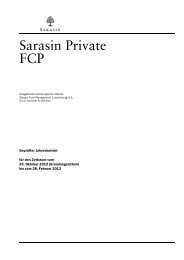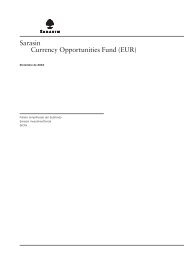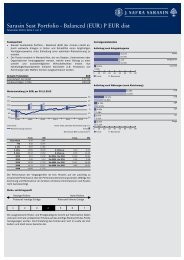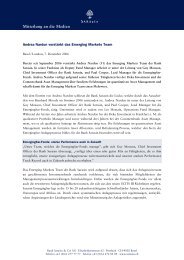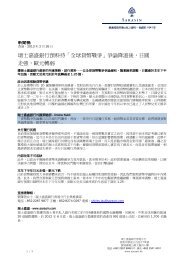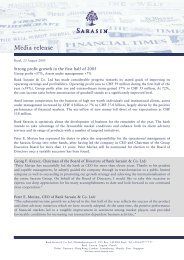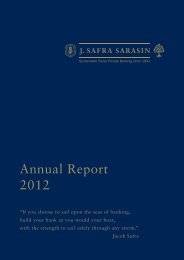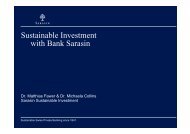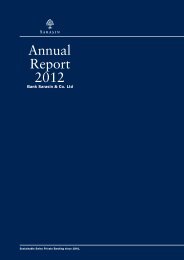Sustainability Report - Bank Sarasin-Alpen
Sustainability Report - Bank Sarasin-Alpen
Sustainability Report - Bank Sarasin-Alpen
You also want an ePaper? Increase the reach of your titles
YUMPU automatically turns print PDFs into web optimized ePapers that Google loves.
Solar Energy 2005<br />
zenegger has recognised this threat and vetoed the law. Unfortunately this puts<br />
the entire programme on ice for the time being. Interest in solar energy has traditionally<br />
been very high in California, and last year almost half of America’s entire<br />
PV capacity was installed in this state. Electricity consumption is particularly high<br />
in the summer in this region, when air conditioners are turned up high. Solar energy<br />
can meet this need very well, as it is particularly suited to dealing with this<br />
type of peak load.<br />
Fig. 11: Short and mid-term market forecast for the US<br />
700<br />
USA 2000 - 2010<br />
Module production p.a. Production cap. at y/e Annual installed PV capacitiy<br />
600<br />
500<br />
[MWp]<br />
400<br />
300<br />
200<br />
100<br />
0<br />
2000 2001 2002 2003 2004 2005 2006 2007 2008 2009 2010<br />
Source: up to 2004 IEA-PVPS, from 2005 <strong>Sarasin</strong><br />
In the entire USA there are more than 50 different PV programmes of individual<br />
federal states and utility companies. However, these fragmented measures have<br />
not had the same sweeping effect as the unified subsidy mechanisms in Germany<br />
and Japan. The key to the US solar market therefore still lies in California.<br />
Cell and module production<br />
pick up again in 2004<br />
Last year cells with a capacity of 138 MW and modules with a capacity of 139<br />
MW were produced in the US. After production fell in 2003, it picked up again by<br />
35% in 2004, while module production rose as much as 95%. This fosters the<br />
hope that the trend will turn positive again. For 2005 we forecast newly installed<br />
capacity of 125 MW (+39%) and 2006 a capacity of 180 MW (+44%).<br />
Other important markets<br />
Spain has attractive<br />
conditions for solar energy<br />
Good conditions for a future booming market exist in Spain, which has now introduced<br />
feed-in tariffs for renewable energy that are even more attractive than<br />
Germany’s. Spain currently offers a tariff of EUR 0.42 per kWh for PV systems<br />
under 100 kW and a rate of EUR 0.22 EUR for systems with an output of over<br />
100 kW (incl. solar thermal power stations), payable over a period of 25 years.<br />
After that, 80% of the tariff is paid until the end of the system’s working life. Soon<br />
the threshold for the programme is due to be raised from the current level of 150<br />
MW to 400 MW for PV systems and from 200 MW to 500 MW for solar thermal<br />
power stations. Some initial teething problems led to certain bureaucratic obstacles,<br />
and made the formulation of the legislation more complicated. But Spain is<br />
obviously a very attractive country for solar energy because of its ample sunshine.<br />
Last year 10 MW of new capacity was installed (+53%). Interestingly, almost<br />
half the installations were greenfield sites (solar parks). Just recently Euro-<br />
Dezember 2005 23



